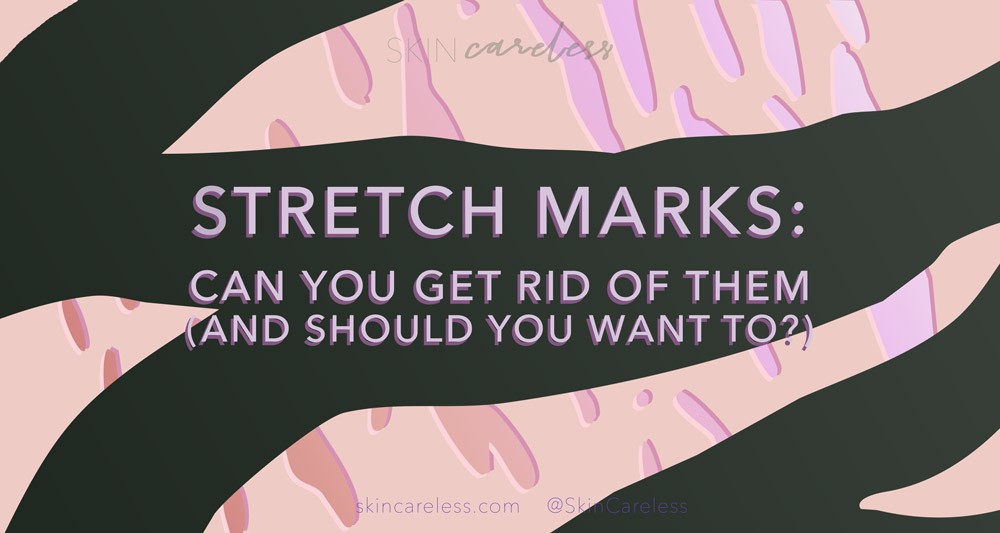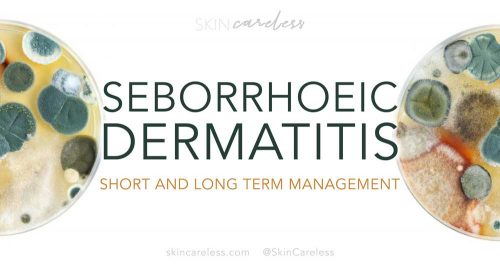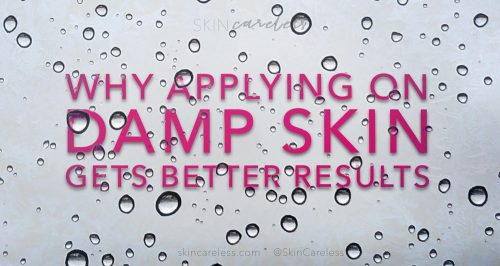There’s a lot of money to be made out there preying on people’s insecurities. The most profitable formula is to point out something that’s natural and unavoidable, make people feel bad for it, convince them they need to change, say you have the solution, and sell. Whether or not that solution actually works is of little consequence.
I love the world of skin care and choose to see the good, but it can be a dark place sometimes. A lot of skin care products are marketed as a one-stop cure for your woes, regardless of efficacy. Even for conditions where in-office treatments or long-term monitored routines are a better bet, you’ll still find a “wonder product” on your local drugstore shelf claiming to be all you need to be rid of it for good. Because that’s all you need – a customer with an emotional desire and some fancy buzzwords.
Today I wanna chat about stretch marks. Let’s be informed consumers and take a deeper glance at this huge slice of the skin and body care pie. They’re the ideal target for this kind of marketing. You get them when you become a teenager, grow tall, put on weight, gain muscle, or have a child – all things that are hard to avoid when living a full life. So if we, the consumer, can be made to feel bad about them, that demand is straight profits for companies who’ve designed stretch mark treatments.
Whether or not you love your stretch marks isn’t really important. If you’ve ignored the comments and embraced them, great! If you don’t like them for your own reasons, no worries!
The main thing is: do these stretch mark products work? Can you really “cure” stretch marks using over-the-counter topical treatments? Should you spend your money here? Or would you be better off buying a good wine and coming to terms with your body, scars and all, instead? Let’s see.
What are stretch marks?
Stretch marks are essentially scars on or below the surface on the skin. As our bodies grow rapidly – in puberty or pregnancy, for example – the collagen and elastin which binds skin together and allows it to be flexible and grow with us can be stretched beyond its capacity. This results in fissures or tears beneath the surface to accomodate the growing bones and muscles and organs. They show up as any colour from red to purple to a shiny white, and look like long and sometimes indented ‘scratches’.
As stretch marks grow older, they can fade, but tend to never go away completely. Their end form – often lighter and with a textural difference to other areas of skin – are the a result of the body filling the weakened and damaged gaps of normal supporting fibres with scar tissue instead, which is inflexible and collagen-dense.
The limitations of topical products
As stretch marks are the result of significant trauma beneath the skin, much like a scar, most topical products are probably not going to be able to eliminate them. The main reason being that a stretch mark is an extreme structural abnormality in the skin, far deeper than your average cream is going to be able to penetrate or have any action. It resides in the dermis, where the blood vessels and nerves are.
The kind of rehabilitation needed to break down and trigger complete and invisible repair of a stretch mark would need to be very potent.
The most popular anti-stretch mark remedies
So why then, if skin care isn’t the likely solution to stretch marks, do so many products and companies claim that theirs is? To find out, let’s take a look at some of the main products circulating in the “treat stretch marks at home” movement, and chat about what they’re doing for you (if anything). Is there any product that does what it claims?
Cocoa (and Shea) Butter
Cocoa butter is one of those home remedies that is passed down from generation to generation. In particular, Palmer’s Cocoa Butter formula is the main hyped-up brand. In conjunction with Shea butter, it’s especially known as a belly hydrator to aid the itchiness that comes along with stretching skin of pregnancy. But also, many people claim it totally prevented them from developing stretch marks.
Cocoa and shea butter are made of fat from the cocoa bean and shea nut respectively. They’re full of fatty acids and oils that are wonderfully hydrating for irritated (and itchy), overstretched skin. But it doesn’t contain any active ingredients that could stimulate magical fibre-healing properties to prevent or treat stretch marks, nor has it been proven to work through any other method.
What’s likely happening here is a case of confirmation bias. Cocoa butter is one of the most popular body lotion ingredients in the world. Pregnant ladies everywhere are told to slather it on to curb itchiness and also as a relaxing massage experience. Most do so because of advice and anecdotes from family and friends. About half of pregnant women will end up with stretch marks – but that also means that half will not. And so those women who use these butters and then end up with no stretch marks will often wrongly associate the product with their streak-free belly, when in reality it was probably genetics and a bit of good luck. Plenty of women use Cocoa or Shea butter and end up as stretch-marked as any other, but we tend to forget about or put aside results that don’t meet our expectations, so you won’t hear so much from these women.
Vitamin E
This is the age-old internet remedy that never seems to die. You’d think Vitamin E oil could cure just about anything. But by far it’s most famous as a stretch mark treatment.
Vitamin E is a vitamin (duh) that’s a potent antioxidant. In short, that means it sacrifices itself to free radicals and prevents damage to our organs – including our skin!
But, before you get too excited, stretch marks aren’t caused by free radicals (brought on by things like sun exposure, smoking and stress). They’re mechanical wounds. Using Vitamin E on a physical scar like a stretch marks is like going to therapy for a broken toe. A perfectly good treatment, but not for this kind of injury.
But some hold firm that Vitamin E has (mostly anecdotal) anti-inflammatory and healing properties, and will help to reduce the severity of stretch marks. Even if that were true, it still doesn’t quite add up. Scars are our bodies’ way of healing. They’re created to protect weak and vulnerable parts from further damage. And a scar is permanent from a self-healing point of view. Once it’s created, the body has done its job of protecting the skin and moves on. Even if Vitamin E was present ahead of the stretch mark forming, and somehow did trigger your body to “heal”, all it would do is make a better, stronger scar. Not a less visible one.
Bio-Oil
By far the most interesting and promising treatment so far, Bio-Oil is a mineral-oil based body oil that along with Vitamin E contains the active ingredient Vitamin A, aka. retinol. Specifically, it contains an ester of retinol called retinyl palmitate. If you’ve read the blog before, you know I (and skin care experts worldwide) am a big fan of retinol for skin regeneration.
Bio-Oil has near cult status for all manner of body problems, with the company and fans alike claiming it can cure everything from ingrown hairs, flaky skin, acne and scars, to name a few. And of course, one of its main claims to fame is the ability to prevent and reverse stretch marks.
Retinol has the ability to repair cell communication, leading to healthier skin from the ground up. It can also repair and reverse antioxidant damage, but as I mentioned before, stretch marks are not a results of antioxidant damage. And stretch marks are scars, which means they are intrinsically and permanently changes areas of skin, that doesn’t tend to respond the way normal skin does any more. However retinol can also trigger the creation of new collagen, which may be able to influence the appearance of existing scars.
Retinoic acid, the most potent version of retinol, shows a lot of promise as a stretch mark solution in small studies. Bio-Oil the company has commissioned studies into their specific product’s effectiveness, and though there are similarly only two small studies relating to its effect on stretch marks, they show potential for at least visual improvement of stretch marks. Unfortunately, these studies are flawed and limited, mostly by size, and of course studies funded by companies are less reliable than third-party sources, so I’d take it with a grain of salt. It does show however that more research is likely to be done, and that there’s no harm in using a product like Bio-Oil yourself and seeing if you make any progress. I won’t write off Bio-Oil completely, and if I ever want to reach for a body oil, it’s probably the one I’d go for.
But instead of spending money on drugstore products, a prescription for tretinoin (also called Retin-A) is a far more viable option. tretinoin contains retinoic acid, which is the strongest and most effective version of retinol available.
Stretch mark treatments with potential
So if many popular creams, serums and oils – aside from some with potential – aren’t up to the task, a skin junkie like me might beg the question: what will? Is there any sure-fire in-office procedure you can save up for to remove stretch marks for good, based on raw clinical data?
The researchers are on the case, and there’s a lot of studies showing that all is not lost.
IPL – which I’ve already dedicated a hugely informative post to – is on the forefront as a non-invasive, safe possible treatment for stretch marks. It’s a treatment that uses high-intensity light to provide energy and heat up the deep layers of skin to promote removal and replacement of damaged skin tissue. Preliminary studies show reduction in length and depth of stretch marks, all with no downtime and a good safety profile
Even more promising is the slightly beefier brother of IPL: laser. Specifically, fragmented CO2 lasers also known as Fraxel. Though these laser treatments cost more, and require more care and downtime, as they work by creating visible damage to microscopic areas of skin to encourage healthy replacement tissue, they seem to be highly effective and require less sessions than IPL. Laser can restore the thickness of the skin, increase elasticity, reduce discoloration and more, provided treatment is early enough.
There are tons of proposed studies to research all possible avenues of stretch mark treatment – like radiofrequency, topical acid exfoliants, microdermabrasion, microneedling and more. All so far have proven more effective than retinoids, so take some time to look into these studies and expect to see even more development soon.
Stretch marks are tricky business. And because of their widespread nature it’s a huge tempting area for companies to pour money into in the form of potentially biased research and widespread marketing campaigns. Unfortunately, there doesn’t seem to be a standard treatment just yet. Though many studies can show “significant improvement in the appearance” of stretch marks, “significant” here refers to statistical clarity, not the perceived amount of improvement. Most results remain fairly limited, and I’ve yet to come across any treatment that can guarantee total resolution and removal of stretch marks altogether.
If you’re dead set on using topical treatments, go for something containing a retinoid, preferably one that’s readily available to the skin like prescription tretinoin. These show the most promise and proven results, unlike can be said for many other at-home treatments.
Otherwise, you might want to look into treatments like lasers which pack a little more punch and could help you make a lot more progress in a lot less time.
It can be tough to accept all our body’s little imperfection and flaws. But remember that just because you’re told you should want to get rid of something, doesn’t mean you need to. Think about whether you’re actually happy with yourself, when instead you’ve been told you should be unhappy. Pop Bio-Oil all over if it makes you feel good – but know you don’t have to. Rock your acne scars and freckles, or cover them if you want. If they’re part of the body that gets you safely through life, above all, celebrate that!






[…] and activity wise – for the next while, and the ageing process begins now. From your stretch marks to your bad habits, your 20s is time to take stock of the body and mind you’re in and make a […]
Stretch mark removal dermalmd serum wonders for me! NO stretch marks throughout pregnancy and lightened up the stretch marks I got on my hips from a previous pregnancy.
Thanks for the recommendation – I’ll take a look at it and see if there’s any interesting ingredients!